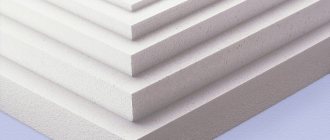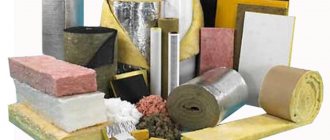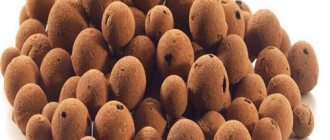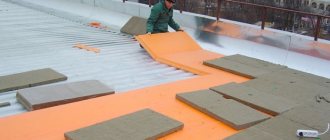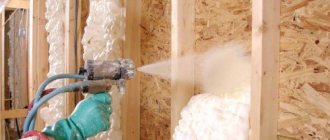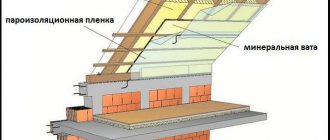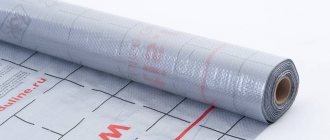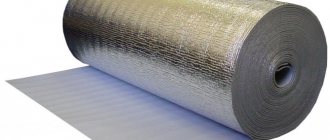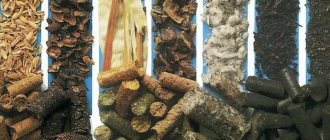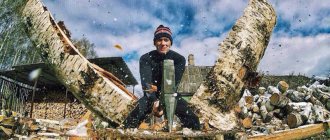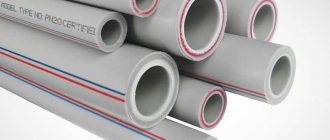Composition and properties of insulation
The following components are usually used in the manufacture of ecowool:
Quantity (%)
up to 80
Recycled waste paper (newspapers). Glossy and coated paper do not meet the specifications and are therefore not used.
12
Antiseptic. Prevents the penetration and development of pathogenic bacteria and fungi (mold)
8
Antipyrine. Reduces the level of fire hazard, makes the insulation unattractive to rodents and other pests
This composition is responsible for the low price of thermal insulation and its environmental safety. In essence, there is no toxic component, however, relatively good technical characteristics are preserved.
Now let's talk about properties. The performance characteristics of ecowool look like this:
Flammability class - G2 . Under the influence of high temperatures, crystallized liquid is released from the fibers of the material; accordingly, the insulation is poorly flammable and does not support combustion processes.
Biostability – high . The composition contains boric acid and borax, which neutralize almost any external factors and aggressive environment, making the material unsuitable for consumption by rodents and other pests.
Thermal conductivity indicators: 0.032–0.041 . The material reliably protects interiors from drafts and cold winds, reduces heat loss, and helps save on heating costs in the winter.
Density – up to 75 kg/m3. This ensures reliable sound insulation of the building and forms a reliable moisture-proofing layer.
In addition, ecowool is not produced in sheets or rolls, so during installation a monolithic thermal insulation is formed, completely eliminating cold bridges, seams and joints.
Ecowool, characteristics
Quite often in the construction nomenclature the term mineral wool is used - it has nothing to do with ecowool, since it is a mixture of fiberglass and various additives, the combination of which is quite harmful to humans. In turn, ecowool or cellulose insulation is a product of recycled wood (paper), with the addition of non-flammable components.
The main distinguishing feature of the material is the absence of harmful fumes and absolute safety for humans. Among other properties it is customary to highlight:
- density (kg/cubic m) – 30-75,
- thermal conductivity (W/m*K) – 0.032-0.041,
- flammability group - G2 - moderately flammable (GOST 30244), B1 (DIN 4102) non-flammable (GOST 30402), D1 - with low smoke-generating ability (2.14.2 and 4.18 GOST 12.1.044),
- breathability – low,
- vapor permeability (mg/(m*h*Pa)) – 0.3, sorption humidification according to GOST 17177.5 for 72 hours – 16%,
- chemical passivity,
- sound absorption (DB) – 63 with a thickness of 50 mm;
- shrinkage (per year) – 1.2%,
- service life 5-10 years.
The density indicator is not very different from polyurethane foam, so the properties are similar.
The thermal conductivity is almost twice as high, therefore, the minimum permissible layer is 10 mm for temperate climates and 20 mm for frosty ones. It should be noted that the operating temperature ranges from -40 to +120 0C. If there are no issues with positive temperatures, then at -45-50 0C ecowool begins to crystallize and collapse completely.
The second group of flammability implies that the material burns very poorly and only under the influence of a direct flame source. In all other cases the fire stops. At the same time, there is practically no smoke, and its components are practically harmless to humans (the effect can be compared with smoking a cigarette, only without the impurities of hydrocyanic acid, tar and nicotine).
Low air permeability, on the one hand, prevents the penetration of cold, but on the other hand, it prevents the walls from “breathing,” which leads to the appearance of mold and mildew (if the rooms are humid or the standard air humidity is more than 70%, typical for maritime cities and regions with heavy regular rainfall) .
The vapor permeability indicator is much higher, which means that active vapors are quickly removed to the outside, while the material itself retains only 15-20% of the total moisture volume. This indicator cannot lead to the appearance of fungus.
Like polyurethane foam, ecowool is practically not susceptible to chemical influences. But, unlike its competitor, it is able to resist acids and solvents, which is why it is used in production.
Another plus is high noise insulation. For comparison, an armored door 200 mm thick has an indicator of 40 dB.
Unlike foam rubber, ecowool shrinks every year. Because of this, gaps in the cracks will appear in 2-3 years, and after 5-6 years the thermal insulation factor will disappear completely. Some companies offer products that have a shrinkage coefficient of 0.5-0.8%, but this does not significantly extend the service life.
Along with the above, the material has many other features.
Advantages and disadvantages of insulating material
Despite the assurances of manufacturers that ecowool is the standard among thermal insulation materials, these statements should not be completely trusted. This is a common marketing ploy designed to increase sales.
The material has a lot of undeniable advantages, but, like its analogues, it is not without serious drawbacks. Let's start with the advantages.
The advantages of ecowool are the following characteristics:
Low moisture permeability. The capillary structure of the material allows it to absorb water without losing its beneficial qualities. For example, if mineral insulation is moistened by only 1% , heat loss will increase almost 10 times . If ecowool is moistened by 25% , the decrease in thermal conductivity will not exceed 5% . This is a very good indicator.
Seamless insulation. The loose mass of filler fills all voids, completely eliminating cold bridges. To achieve a similar result with roll or sheet insulation, the material must be laid in 2-3 layers , which increases the final cost of the work.
High level of noise absorption . Ecowool is an excellent way to insulate buildings located on busy streets, near federal highways, railway lines and airports.
In addition, an undeniable advantage is the affordable price, which elevates ecowool to the rank of the most popular insulation for private construction.
Let's move on to the problems. Serious disadvantages of thermal insulation include the following:
Gradual decrease in thermal insulation properties , increased heat loss. This is due to the fact that the material decreases in volume or becomes oversaturated with moisture. Problems can be avoided by laying insulation with a margin of 20-30% of the calculated volume and making the layer ventilated so that moisture can evaporate into the atmosphere.
Difficulties during installation. In order for the insulation to fully meet the technical specifications, special installation equipment will be required. This means that you will have to hire a team of professionals, and this is an additional expense.
Waste of time. Ecowool can be laid in two ways: dry and wet installation. The first option creates a lot of dust during the work and does not guarantee high-quality compaction. The second one creates a high-quality layer of thermal insulation, but the material will dry for about 3 days , which is not always possible at the pace of modern construction.
Relatively low rigidity . If we compare ecowool with other types of insulation, for example, foam boards, its rigidity will be noticeably lower, which prevents the material from being used for frameless insulation.
Shrinkage of the material. It occurs with vertical insulation already in the second year. There is no way to avoid this problem.
Burning speed up to 30 seconds. This means that the material does not burn, but smolders slowly. The result is a risk of ignition of adjacent materials and high smoke levels.
Similarities between penoizol and ecowool
Ecowool is a thermal insulator made from fluffed cellulose. It occupies 80% of the composition. The remaining twenty percent is occupied by boric acid (12%) and borax (8%). Unlike penoizol, it contains almost no harmful substances, that is, it is harmless to humans. Liquefied foam plastic is not toxic, but it releases formaldehyde into the environment - substances that provoke the growth of cancer cells. Ecowool is applied using dry and wet-adhesive methods. The second strongly resembles the process of thermal insulation with urea-formaldehyde building materials. Regardless of the chosen scheme, it is better to trust specialists with higher education and confirmed qualifications for insulating houses with both materials.
Similarities between ecowool and penoizol in terms of technical characteristics:
- The described building materials have approximately identical thermal conductivity - ecowool - 0.039, penoizol 0.038 (W/m*K);
- Insulation is applied to horizontal and vertically vertical surfaces under pressure using special units;
- Manual thermal insulation without the use of special equipment is available for both insulators.
- After application, ecowool and penoizol form a seamless layer of thermal protection, eliminate cold bridges, and reduce the dew point.
- A significant difference is hidden in shrinkage - penoizol shrinks by 1-3%, ecowool rarely shrinks above 0.5 percent;
- Liquid polystyrene foam does not ignite, thanks to chemistry; ecowool does not burn due to a fire retardant in the form of boric acid;
- The vapor permeability of the analyzed insulators is also close to each other - penoizol 0.24, cellulose wool 0.30 m*h*Pascal.
Other differences between penoizol and ecowool
Another significant difference is moisture saturation. Building materials specifically designed for insulating walls, floors and ceilings absorb liquid in different ways. Thanks to the capillary structure, ecowool has a water absorption of 23%, which does not increase heat conductivity. Water particles replace fibers and increase the quality of thermal insulation. Similar properties of penoizol are inferior to cellulose wool. For this reason, liquefied foam is not used in thermal insulation of objects with humidity above 60 percent. A foundation or base thermally insulated with foam insulation will be cold. Blackening, girdling, concrete-destructive mold will begin to accumulate in it.
But the most significant advantage of ecowool over its urea-formaldehyde analogue is the absence of a specific odor. Cotton wool made from recycled paper by grinding it into powder does not smell and does not emit harmful substances that could cause harm to the body. Penoizol (depending on the quality of the manufacturer) is treated with formaldehyde. When this product enters the lungs, it provokes various disorders, including the growth of cancer cells. Some builders a priori refuse to work with him for this reason. Manufacturers assure that upon completion of drying, the material ceases to be harmful to humans. All you need to do is wait for it to dry and completely set into a dense pillow.
Similarity in the effect of insulation on human health
According to a recent statement by one of the managers of a penoizol production company, the improved technology for producing liquid foam meets the rules of the world standard for environmental friendliness. For some time in the United States of America, as well as in Canada, the material was legally prohibited for use in insulating private cottages. Last year (2019), the ban was eliminated, recognizing the insulation as safe for humans with strict adherence to the installation instructions, which contained many individual points. The government of Great Britain, as well as some other regions of Europe, adopted a law allowing the use of penoizol in thermal insulation of industrial buildings.
Environmentally friendly wool, unlike its main competitor in the building insulation market, is approved for use at all levels. Meets the international safety standard ISO 14001. It does not contain formaldehyde and other components that are rich in competitive insulators - mineral, basalt, slag wool. Polystyrene foam, foam glass, and various fiberboards are not deprived of chemically active substances. Despite this, ecowool can still harm the body due to paper dust, which will cause a person to sneeze and cough for a long time. That is why when working with this insulation it is recommended to wear a respirator or an ordinary mask that protects the respiratory tract.
Minvata
Mineral wool is one of the most common types of insulation for insulating various elements of a building, that is, insulation is laid in the roof, floor and interior floors, floors, walls, both inside and outside the room. Tiled or rolled mineral wool allows you to quickly insulate a house, bathhouse, and various utility and non-residential premises.
Such popularity of mineral wool is easily explained by the wide selection of varieties, brands, and availability in retail chains. Also low cost, ease of installation, high heat and sound insulation characteristics. But there is another side - a negative one, which sometimes outweighs all the positive qualities of many varieties and brands of mineral wool. The use of formaldehyde resins as a binding component to form an insulating layer significantly reduces its environmental friendliness, but reducing the component reduces the moisture resistance of the finished insulating material. Only some types based on basalt fiber do not contain harmful toxins. In its pure form, it is difficult to impart the required density to mineral wool; there remains a risk of dust from mineral fibers getting into the air of the insulated room, so it is mainly produced in rolls or mats with already formed density and rigidity.
Adhesion and installation features
Adhesion is the ability of a material to “stick” to the application surface. The more tightly the material “grabs” to the surface, the better the thermal insulation. Ecowool, polyurethane foam and mineral wool have good adhesion to vertical surfaces (walls). However, for installing thermal insulation on ceilings and other horizontal surfaces, the adhesive substance contained in mineral wool and ecowool is not enough, while polyurethane foam adheres perfectly to any surface.
Advice from a pro There are two main types of exterior wall finishing insulated with polyurethane foam - siding and plaster. Each method has its own subtleties of applying polyurethane foam, which are important to know in advance for proper preparation of surfaces and subsequent finishing.
Disadvantages of tile and roll insulation
Yes, rolled and tile mineral wool is easy to install - roll out the roll or mark out the slab, cut off the required piece of a given size and insulate the accessible cavity. But ease of installation is not a parameter that should be followed when choosing insulation. When cutting rolled insulation, waste is inevitable; consumers overpay in advance for the excess, which will still have to be disposed of.
Mineral wool is intended for insulation of buildings made of various materials with different number of storeys and of various types, but when auditing its installation with a thermal imager or when opening it, loose joints and loose fit are often discovered, and these are, as a rule, drafts and cold islands - the main reasons for dampness of the insulation and , accordingly, loss of thermal insulation qualities. For this reason, mineral wool loses about 40% of its heat-saving properties already in the first years. And this is not always due to poor quality installation. The subsidence of the mats causes moisture, destruction of fragile stone fibers by ice crystals. And when the process is started: moisture - destruction - subsidence - the situation gets worse with each season. In such a house, preserving heat will be very, very expensive, and don’t forget that mice and rats inhabit mineral wool comfortably.
But there is an alternative that belatedly appeared on the Russian construction market in the 90s after it conquered low-rise construction in neighboring Europe and many more distant countries.
What is better for insulation: polyurethane foam or ecowool?
Most of us are constantly faced with the problem of choice. It's one thing when the choice concerns small and everyday tasks, another thing when it concerns serious issues of quality and durability. In this article we will try to help you avoid negative experiences in matters of insulation.
Polyurethane foam is the most widely used and environmentally friendly insulation material. This has been proven not only by professional tests, but also by many years of experience in using this material in construction. High chemical resistance significantly increases the service life. Currently, polyurethane foam is used in the production of products such as pillows, chairs, mattresses, etc. It is also used in medicine, beekeeping, as a heat insulator in refrigeration equipment and in other branches of human activity. And of course, polyurethane foam is an excellent insulation material for buildings and premises. We ourselves don’t notice how often we encounter it. This material is safe from an environmental point of view, and also, which is very important when choosing insulation, is not of interest to rodents. The main components of this material are isocyanates (organic compounds containing the functional group -N=C=O) and polyols (polyhydric alcohols). They are produced on the most modern equipment by companies such as DOW, BAYER, Ecothermix and BASF.
Ecowool, consisting of finely crushed waste paper mixed with chemicals, is considered a less environmentally friendly material. Chemicals are usually used to increase moisture resistance (hydrophobes), reduce flammability (fire retardants) and various poisons that counteract microorganisms and rodents. These circumstances, as well as low-quality and outdated equipment, make ecowool not only environmentally harmful, but sometimes even dangerous to human life.
Properties of insulation When choosing the best way to insulate a house, you need to pay special attention to the thermal conductivity, moisture resistance and fire safety of materials. Polyurethane foam is a self-extinguishing insulation material, which means that the fire on it goes out quite quickly without spreading over large areas. And ecowool, despite containing fire retardants, burns very well due to its composition. PPU is a closed-cell type insulation, which means its high thermal conductivity and moisture resistance. Ecowool, on the contrary, is an open-cell insulation, and when using it, you need to make a vapor barrier to protect it from moisture. This is due to the fact that moisture greatly affects the thermal conductivity and service life of the material. Due to the increased humidity of the material, mold may appear, and subsequently rot.
The question of what is the best way to insulate a house needs to be approached responsibly, especially in the harsh Russian climate. Therefore, we recommend that you entrust this process to professionals. You should always choose insulation wisely, especially in our climate. Therefore, we recommend that you entrust this process to professionals.
Just contact us in any way convenient for you, call in Barnaul 55-55-99 or order a free measurement. Our specialists will assess your project in the shortest possible time and give free detailed advice on polyurethane foam insulation, because the TKS company values its clients!
Ecowool
It's time to think about what influence we, voluntarily or unwittingly, have on the world around us, on ourselves and on the people close to us. Therefore, construction companies in Europe and the West are concerned not only with how to build a house at the lowest cost, but also strive to use environmentally friendly materials in construction. The demand from consumers of construction services for safe materials has also increased. Many are willing to overpay, but live in a clean environment at home and not pollute the environment. This is the choice of modern man. There is no need to overpay for ecowool, nor do you have to doubt its environmental friendliness. Definitely a budget option, affordable for many, but guaranteeing safety, energy saving and care for natural resources.
What is ecowool
Remembering that suburban construction in Russia began to actively develop in recent times, ecowool appeared relatively recently in St. Petersburg and the Leningrad region. Acquaintance with Ecowool in low-rise suburban construction in St. Petersburg began in unfavorable conditions for it: it was unclear about the supply of cellulose insulation, not to mention the equipment for installing Ecowool, although it was used in Europe even in pre-war times. But even in our time, we still hear from construction teams who have built more than one country house: ECO-WOOL - what is it?
Ecowool is an environmentally friendly material that consists entirely of natural ingredients:
- borax – 7%;
- boric acid – 12%;
- recycled cellulose – 81%.
The loose consistency of ecowool allows for seamless installation, after which there will be no drafts, mice or insects in the house. There is no problem with residues - there is no waste during installation, every gram of ecowool will reliably protect your home.
Rid your home of rodents and insects
To permanently protect your home from the invasion of rats and mice, as well as insects, you do not need to use toxic chemicals - just insulate the house with ecowool, and these uninvited guests will lose interest in your home.
The fact is that both insects and rodents cannot live next to ecowool - they cannot tolerate the borates that it contains. Boric acid and its salts are non-volatile, resist fire, and are safe for humans. Consequently, the use of cellulose insulation allows you to solve a number of important problems:
- increased thermal insulation;
- increased sound insulation;
- protecting your home from rats and insects;
- protection from drafts;
- natural regulation of home humidity;
- absence of mold and mildew.
Theoretical aspects
Insulation has several main goals:
- prevent the penetration of cold from the street,
- retain heat indoors,
- reduce gas (coal, firewood) or electricity consumption.
Based on these main tasks, two types of insulation are distinguished:
- internal,
- external.
Internal insulation allows you to increase sound insulation in hollow structures, for example, made of plasterboard. In addition, such a thermostat does not require additional finishing. It is especially important to use internal insulation if the facade of the house is built of beautiful brick, which does not require additional decorative work.
However, this method does not allow creating a monolithic protective layer if we are talking about two-story or more buildings. Internal insulation does not allow high-quality insulation of slabs of interfloor partitions. Another disadvantage is the reduction in the internal space of the room.
It has lower thermal protection indicators compared to external insulation. The advantage is that it is quite easy to control the microclimate.
External insulation is especially important if the house is built of cinder blocks or shell rock, as it will allow you to perfectly level the surface and save on plaster.
The disadvantage is that external insulation, even under a layer of plaster, remains quite soft and is highly susceptible to any mechanical damage. Therefore, additional costs will be required for cladding the lower part of the first floor with decorative stone.
External insulation is characterized by the fact that it creates an analogue of a thermos from the house. In winter this is very convenient, but in summer you will definitely need air conditioning in the rooms, otherwise they will be incredibly hot.
Now let's take a closer look at the materials themselves.
Maintaining humidity in the house
This property of ecowool is well known - natural regulation of humidity in the house. The process is ensured due to the properties of the insulation: it accumulates moisture when there is an excess of it in the air and releases moisture back when it is lacking, for example, during the heating season. By the way, ecowool absorbs moisture into itself, that is, moisture is absorbed into the fibers themselves, leaving the air between the cellulose fibers minimally humid, unlike mineral wool (if we return to the question: which is better - ecowool or mineral wool), and moist air is a conductor cold.
Moisture resistance
It is the ability of insulation to accumulate moisture that worsens its thermal insulation properties during operation, and also contributes to accelerated destruction. Unfortunately, mineral wool and ecowool have high vapor permeability, which is why these insulation materials do not in any way protect the building structure from the corrosive effects of moisture. Moisture absorption can be reduced, but this requires additional work and costs. When deciding which is better - polyurethane foam or mineral wool, it is important to consider that polyurethane foam practically does not accumulate moisture and is insensitive to steam due to its closed-cell structure.
Disadvantages of ecowool - myths and reality
But ecowool is also not ideal, there is a drop in the ointment, a page of our website is dedicated to it. But we’ll try to dispel some misconceptions about toxicity here.
The first argument of ecowool opponents from among competitors: “Boric acid belongs to class III. dangers" and cite GOST 18704-78 as a weighty argument. However, having opened GOST, you can easily understand that these are specifications for the production of boric acid and there is a direct link to the classification of chemicals - GOST 12.1.007-76, which explains in detail that the third class is moderately dangerous among chemicals. Along with boric acid, the list includes nickel, aluminum, manganese, iron, silver, etc. We hope that after these discoveries you won’t want to throw away your family silver? And a dose of boric acid taken orally is considered toxic: 15-20 g (tablespoon) for adults and 4-5 g for children.
The second argument is that “ecowool generates dust when installed dry.” But how many construction and finishing operations can be considered “clean”? There is no point in arguing here - it’s a normal working moment.
The third argument against ecowool is that it is essentially cut newspaper, and printing ink is harmful.” The days when paints contained heavy metals are long gone - expensive and not profitable. Today, printing houses use pigment and mineral oils.
Another argument is that “small producers do not provide the proper quality.” Manufacturers of many materials are guilty of this, and we always encourage careful selection and verification of certificates of conformity. We ourselves work only with reliable partners. And we feel free to talk about the disadvantages of ecowool.
Ecowool or penoizol
Ecowool is not the only seamless insulation material, but it is the only one with a natural organic base. None of the insulation materials that can be poured, sprayed and even glued into the cavity of structures: walls, pitched roofs, floors and various ceilings has such a unique opportunity - to be identical in nature to wood and become one with wooden structures. Let's look at the example of the choice: “ecowool or penoizol”?
The main raw material in the production of penoizol is urea-formaldehyde resin - hazard class 2 - a product of polycondensation of urea with formaldehyde. When pouring, penoizol releases these formaldehydes - substances hazardous to human health. The polymerization process is not always irreversible. When heated, reverse processes are inevitable - the toxic smoke of modern fires is caused precisely by the toxins of burning polymers. But the choice: “ecowool or penoizol?” You will have to do it yourself, although our clients prefer not to take risks when there is natural material and reliable installers from the Teploservice Company.
Which insulation is better, who to trust with insulation
When choosing between price and quality, it is not always worth focusing on cost, but as usual, there are exceptions: an unsold newspaper simply cannot be expensive, and competition does its job.
Therefore, let the builders build, and it is better to trust independent teams with insulation. And let the electrician run the wires, the roofer cover the roof, the plumber supply the water, and the environmentalist, who uses insulation that is safe for human health, insulate the house. “What is better than ecowool or mineral wool” or “ecowool or penoizol” is still up to those who make a choice between these materials.
